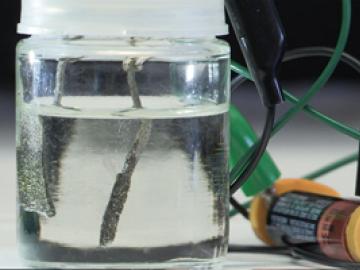Filter News
Area of Research
- (-) Chemistry and Physics at Interfaces (7)
- (-) Mathematics (1)
- (-) Transportation Systems (6)
- Advanced Manufacturing (20)
- Biological Systems (3)
- Biology and Environment (134)
- Biology and Soft Matter (4)
- Building Technologies (9)
- Chemical and Engineering Materials (4)
- Clean Energy (320)
- Climate and Environmental Systems (11)
- Computational Biology (2)
- Computational Chemistry (5)
- Computational Engineering (3)
- Computer Science (13)
- Data (1)
- Earth Sciences (1)
- Electricity and Smart Grid (2)
- Energy Frontier Research Centers (7)
- Energy Sciences (2)
- Fossil Energy (1)
- Fuel Cycle Science and Technology (2)
- Functional Materials for Energy (8)
- Fusion and Fission (36)
- Fusion Energy (15)
- Geographic Information Science and Technology (1)
- Isotope Development and Production (1)
- Isotopes (26)
- Materials (197)
- Materials for Computing (23)
- Materials Synthesis from Atoms to Systems (8)
- Materials Under Extremes (7)
- National Security (53)
- Neutron Data Analysis and Visualization (4)
- Neutron Science (107)
- Nuclear Science and Technology (45)
- Nuclear Systems Modeling, Simulation and Validation (2)
- Quantum Condensed Matter (3)
- Quantum information Science (7)
- Renewable Energy (4)
- Sensors and Controls (4)
- Supercomputing (194)
News Type
Media Contacts

Oak Ridge National Laboratory researchers developed and demonstrated algorithm-based controls for a hybrid electric bus that yielded up to 30% energy savings compared with existing controls.

Researchers at Oak Ridge National Laboratory have identified a statistical relationship between the growth of cities and the spread of paved surfaces like roads and sidewalks. These impervious surfaces impede the flow of water into the ground, affecting the water cycle and, by extension, the climate.

Researchers at Oak Ridge National Laboratory proved that a certain class of ionic liquids, when mixed with commercially available oils, can make gears run more efficiently with less noise and better durability.
It’s common knowledge that driving aggressively can dent gas mileage, but it’s difficult to determine exactly how much gas drivers waste. A new study by researchers at the Department of Energy’s Oak Ridge National Laboratory has quantified the impact speeding and slamming on the brakes has on fuel economy and consumption. They found that aggressive behavior behind the wheel can lower gas mileage in light-duty vehicles by about 10 to 40 percent in stop-and-go traffic and roughly 15 to 30 percent at highway speeds. This can equate to losing about $0.25 to $1 per gallon.

From the bluebird painting propped against her office wall and the deer she mentions seeing outside her office window, Linda Lewis might be mistaken for a wildlife biologist at first glance. But rather than trailing animal tracks, Lewis, a researcher at the Department of Energy’s Oak Ridge National Laboratory, is more interested in marks left behind by humans.

With more than 30 patents, James Klett is no stranger to success, but perhaps the Oak Ridge National Laboratory researcher’s most noteworthy achievement didn’t start out so hot – or so it seemed at the time.

Andrew Stack, a geochemist at the Department of Energy’s Oak Ridge National Laboratory, advances understanding of the dynamics of minerals underground.







